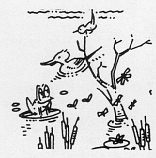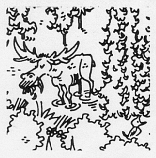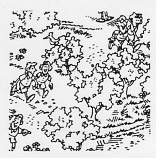|
|
Wetlands Poster - Grade School
ESTUARINE WETLAND TYPES -- Continued
 |
Mangrove Swamps
The type of water is saltwater, and the dominant plants are mangrove
trees. Mangrove trees have stilt-like roots to give them stable
footing. Birds include egrets and ibis. Mangrove swamps are located
primarily along southerly parts of Florida coasts and in Puerto
Rico. |
INLAND WETLANDS --
Wetlands that are not affected by
tides. The type of water can be freshwater or saltwater.
INLAND WETLAND TYPES
 |
Inland Marshes and Wet Meadows
The type of water is freshwater or saltwater, and the wetland
is covered with shallow water much of the time. Vegetation is
characterized by emergent and soft-stemmed plants, such as grasses,
sedges, bulrushes, and cattails. These wetlands have many different
kinds of flowering plants. Representative animal life includes
marsh wrens, pintail ducks, bullfrogs, dragonflies, and mosquitoes.
These wetlands occur throughout the United States in low-lying
depressions. |
 |
Forested Wetlands
The type of water is freshwater, and the soils are often waterlogged
in winter and early spring, but can be dry in summer. Vegetation
primarily consists of trees. Black spruce trees represent the
northern forested wetlands and bald cypress the southern forested
wetlands. Representative animal life in northern forested wetlands
includes woodpeckers, wood ducks, moose, and snowshoe hares. Representative
animal life in southern forested wetlands includes raccoons, opossums,
and alligators. Forested wetlands often accumulate dead organic
matter called peat. Forested wetlands can be found in many areas
of the United States. |
 |
Shrub Wetlands
The type of water is freshwater, and the vegetation type is characterized
by woody vegetation less than 6 meters in height, such as black
willows. Representative animal life includes red-winged blackbirds,
mice, and muskrats. This wetland type is one of the most widespread
in the United States and is very important in the Desert Southwest.
Shrub wetlands primarily occur along rivers and streams and around
lakes and reservoirs. |
OTHER WETLANDS --
Wetlands in rivers, lakes, and reservoirs.
These wetlands are shallow-water habitats or unvegetated wetlands.
Water is less than 2 meters deep. These wetlands may include a
shoreline fringe of water lilies and underwater plants, or they
may provide a home for small animals on an unvegetated streambed,
beach, or bar. Representative plants and animals found in lake
and reservoir wetlands include duckweed, water lilies, water striders,
beavers, shrews, red-winged blackbirds, and osprey. Bears, snakes,
mayflies, and water lilies might also be found in river wetlands.
|